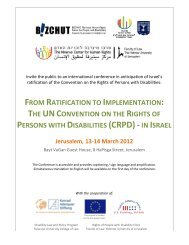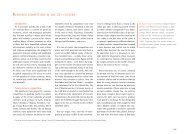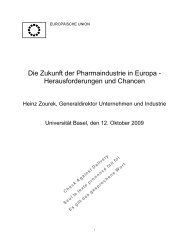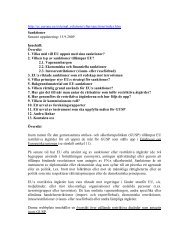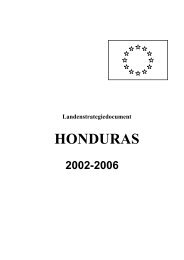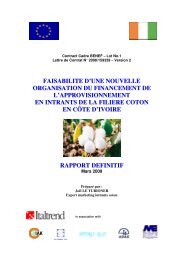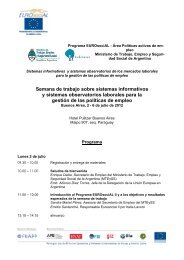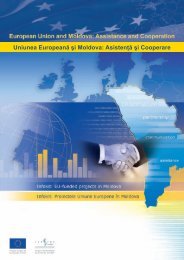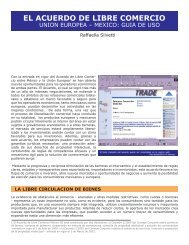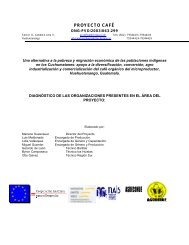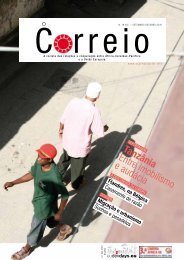Regional Reports - the European External Action Service
Regional Reports - the European External Action Service
Regional Reports - the European External Action Service
You also want an ePaper? Increase the reach of your titles
YUMPU automatically turns print PDFs into web optimized ePapers that Google loves.
2.2. Distribution of NSA in ANRS<br />
The distribution pattern varies according to <strong>the</strong> typologies. Most of <strong>the</strong> international NGOs and<br />
FBOs are concentrated in <strong>the</strong> drought prone and food insecure zones of <strong>the</strong> region. Table 4<br />
presents <strong>the</strong> zonal distributions of NGOs and <strong>the</strong>ir projects within Amhara. North Shoa, which is<br />
<strong>the</strong> closest to Addis Ababa and also <strong>the</strong> drought prone zone, has <strong>the</strong> highest rank both in number<br />
of operational NGOs and <strong>the</strong>ir programmes and projects. It appears that a number of national<br />
NGOs have opted to roll-out <strong>the</strong>ir programmes out of Addis Ababa to this zone as <strong>the</strong> logistical<br />
requirements are relatively affordable or manageable.<br />
Table 4. Zonal Distributions of ongoing NGO projects in ANRS<br />
S/No Administrative Zone<br />
No of<br />
NGO's<br />
No of ongoing<br />
Projects<br />
% of<br />
Projects<br />
1 North Shoa 34 61 19<br />
2 South Wollo 30 51 16<br />
3 North Gonder 24 29 9<br />
4 North Wollo 22 45 14<br />
5 Bahir Dar 22 31 10<br />
6 South Gonder 16 38 12<br />
7 Region 11 15 5<br />
8 West Gojjam 10 14 4<br />
9 East Gojjam 11 16 5<br />
10 Waghemra 6 9 3<br />
11 Oromia 4 4 1<br />
12 Awi 4 4 1<br />
Total 317<br />
Source based on data from <strong>the</strong> <strong>Regional</strong> FS&DPPO<br />
To a large extent <strong>the</strong> NSA landscape is dominated by institutions that have urban-based origin<br />
and focus. This situation is expected and unavoidable. For example, <strong>the</strong> HIV/AIDS pandemic had<br />
<strong>the</strong> greater impact so far on <strong>the</strong> urban population; hence most of <strong>the</strong> anti-AIDS clubs and<br />
Reproductive Health Associations are of urban origin and focus.<br />
In <strong>the</strong> rural areas cooperatives and local branches of <strong>the</strong> region-wide membership-based<br />
associations are omnipresent. According to <strong>the</strong> Cooperative Promotion Agency, about 1.88<br />
million people (which is about 64% of <strong>the</strong> rural house-holds) are members of <strong>the</strong> various<br />
agricultural cooperatives. At local level, particularly <strong>the</strong> region-wide membership-based<br />
associations are invisible, due partly to capacity and positioning. In Gubalafto Woreda of North<br />
Wollo, <strong>the</strong> Secretary of <strong>the</strong> Woreda Women's association is sharing <strong>the</strong> office space and<br />
operational budget of <strong>the</strong> Woreda Women's Affairs' Office. On <strong>the</strong> o<strong>the</strong>r hand, apart from ORDA,<br />
it has no operational partnership and linkage with o<strong>the</strong>r NGOs and FBOs operating in <strong>the</strong><br />
Woreda.<br />
In summary, <strong>the</strong> current distribution of NSA is biased and in favour of urban and drought prone<br />
parts of <strong>the</strong> region. Perhaps more coordinated effort is needed to ensure that more and more NSA<br />
focused to <strong>the</strong> rural and agricultural innovation and intensification fields are brought to <strong>the</strong><br />
picture.<br />
111




